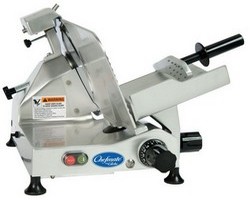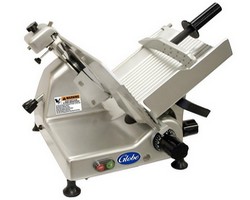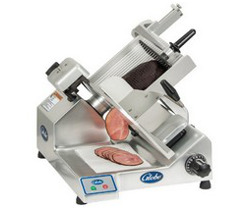In a commercial kitchen, a good slicer can be one of the most useful tools at your disposal. Commercial slicers can handle a variety of tasks. Because of their many uses, one can find several options available for slicers. Not every slicer is the best fit for every situation in the commercial kitchen.
The number one determining factor in choosing a slicer is not price, but application. Your menu will determine how often you use your slicer, and for what purpose. Choosing the wrong slicer can result in costly repairs, and added cost of ownership. Choosing the right slicer will increase quality, productivity, and profitability in your operation. With that in mind, this blog will serve as a guide to choosing the right slicer for any application.
What Are You Slicing?
The most important thing to consider is exactly what you will be slicing. Not all slicers can perform every slicing task. If you will be slicing cheese for example, you will need a more powerful slicer. Cheese is dense and the texture creates more friction. You will need a slicer with at least a 1/2 HP motor for slicing cheese. If you buy an underpowered slicer to slice your cheese, you will likely burn up the motor.
Will you be slicing frozen meat? A good frozen meat slicer is very useful for dishes that call for thinly sliced strips of meat. Some examples include Phở (the Vietnamese noodle soup), and Mongolian barbecue. The trick to slicing the raw meat so thin is to slice it while it is still frozen. But not every slicer can handle the job. You will need a frozen meat slicer with a serrated knife and at least a 1/2 HP motor. Again, if you buy a slicer that is not equipped for the task, you will likely damage it.
Manufacturer’s Warranty
This brings up another issue. Most commercial slicer manufacturers are very specific about their warranty. If you use your slicer for other than the intended purpose, the repair may not be covered under the warranty. When shopping for a slicer, check the manufacturer’s specifications and the warranty. That way, you ensure that you buy a slicer designed to do the work you need it to do.
Size and Space
Another important detail to consider is the size of the slicer. You might have limited space in your kitchen and need a slicer with a small footprint. Are you working with larger items like bacon or country ham? Then you will need a slicer with a carriage large enough to handle the work. You will also need a slicer with a larger knife. The more surface area you need to slice, the larger the knife you need. Refer to the manufacturer’s specification sheets for dimensions.
Options and Accessories
Do you need any accessories or extra features for your slicer? For example, are you looking for an automatic slicer or a manual slicer? What about the finish? Commercial slicers are available in aluminum and stainless steel. Stainless is easier to clean, but is more expensive than aluminum. Are you slicing large amounts of vegetables? Consider a vegetable hopper to help speed up production.
Frequency Of Use
Your menu will determine how often you use your slicer. Not every foodservice operation needs the most high-powered slicer. A burger restaurant might need a slicer to slice only tomatoes and onions, while a deli might need a slicer for ninety percent of their menu. Consider your menu and consider how often you need your slicer. Try to determine how many hours total per day you will use your slicer. If you need a slicer for an hour or less per day, a smaller, lower-powered economy slicer may be appropriate. For one to four hours per day, and medium duty slicer is a better fit. If your menu demands a slicer for all-day, continuous use, nothing but a heavy duty slicer will do.
Featured Slicers
Now that we know what to look for, let’s take a look at some examples of some specific slicers and their applications.
 Globe C12
Globe C12
First let’s take a look at an economy slicer, the Globe C12. Globe’s C Series slicers are light duty slicers for smaller foodservice operations. They are an excellent choice for menus that call for a low volume of slicing. They are compact in size, making them a great fit for kitchens with limited space. C Series slicers are ideal for kitchens slicing meat and produce only. Globe’s C12 slicer features a 12” belt-driven knife with a 1/3 HP motor. It is rated for 1 hour of slicing per day. The C12 carries a one-year parts and labor warranty.
 Globe G14
Globe G14
Next, we have a medium duty slicer, the Globe G14. Globe’s G Series slicers feature enhanced safety and ergonomic features. They have an endweight with an improved grip to keep the hand farther away from the knife. The 35° angle food chute makes slicing easier and reduces waste. The hollow ground blade has a hardened metal allow that stays sharper longer. Globe’s G14 slicer features a 14” belt driven knife with a 1/2 HP motor. It is rated for 6 hours of slicing per day. The G14 carries a one-year parts and labor warranty.
 Globe S13
Globe S13
Finally, let’s look at a heavy duty slicer, the Globe S13. The S Series slicers feature a one-piece anodized aluminum base for easy cleaning. The precision indexing is capable of producing slices from paper-thin, all the way up to 1-1/8 inches. The larger carriage and base give the operator the ability to work with larger products. The clear-text graphic user interface allows the user to select the speed and stroke length, and to read diagnostics. The S13 is perfect for busy kitchens that need a slicer for all-day operation. The S13 carries a two-year parts and labor warranty.
The important thing to remember is that different slicers have different applications. What you need a slicer to do exactly will help you determine which one is right for you. With a little product knowledge on your side, you should be able to find the right slicer that fits your needs and your budget. You can find all these slicers and more in our store at 3110 Preston Hwy in Louisville, KY or you can click here to shop online.

